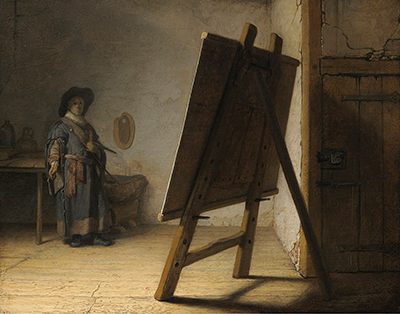The Artist in his Studio is a theme used by many artists, sometimes for portraits of others, sometimes as self-portraits of themselves
Rembrandt used this idea in a number of paintings, etchings and sketches, with the best known iteration found in this page. Completed in 1626, this painting can now be found at the Museum of Fine Arts in Boston, USA.
Artist Rembrandt does not try to give an elaborate, somewhat false picture of life as an artist as many others have done. Instead you will find a bare room, decorated only with the occassional cracked edge. He is not attempting to portray his life as overly grand or priviledged, quite the opposite in fact.
The pose of the artist here is intriguing. He may be gazing at his work from a far, in order to see how others would experience his painting. Alternatively, he may in fact be posing for this painting, we are not sure. The point to this work is probably the concentration of the mind in the early stages of the creative process. There are no distractions in the room, his mind is purely focused on the canvas.
An aggressive use of light and shading helps to further lead the viewer's eyes towards the key elements of the composition. There is also a sense of nervousness at the prospect of beginning this new work, with the angle of the work deliberating allowing the canvas to dwarf the artist through the principles of perspective.
There were some brown wash and ink sketches by Rembrandt that covered this same topic and were equally sparse in terms of detail within the room. The Getty Museum displays one of these and despite the difference in medium, the composition and atmosphere to this drawing is remarkably similar.




